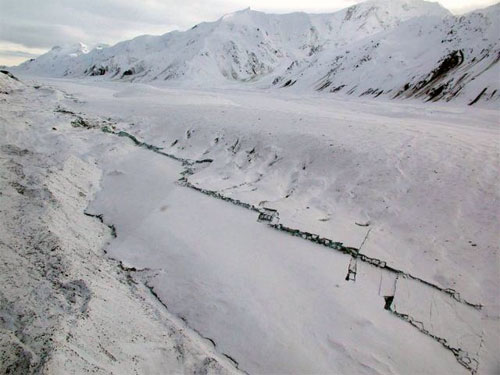 Alaska Science
Alaska Science
Alaskans have enjoyed good earthquake
luck since 1964
By NED ROZELL
February 15, 2014
Saturday PM
(SitNews) - At the 50th anniversary of one of the world’s largest earthquakes, State Seismologist Mike West says Alaskans might learn a lesson from New Zealand.
Here in this land at the meeting point of two restless crustal slabs, no one has died by earthquake since 1964. The magnitude 7.9 Denali Fault earthquake zipped a jagged line through 200 miles of glacier ice and tundra in 2002. A magnitude 7.5 earthquake ruptured just off the coast of Southeast Alaska in 2012. But the immense energy of both earthquakes rippled away from our towns and cities.
“If you’re not careful, the take-home message is that magnitude 7.5’s don’t hurt anyone in Alaska,” West says. “That’s tremendously naïve.”

A crack in the Alaska Range’s Canwell Glacier shows the energy released by the magnitude 7.9 Denali Fault earthquake that shook Alaska in 2002.
Photo by P. Haeussler, U.S. Geological Survey
West, state seismologist and head of the Alaska Earthquake Center, points to an event in New Zealand that could happen here. In February 2011, a 6.1 earthquake near Christchurch killed 185 people (115 when a six-story building collapsed) and destroyed thousands of homes.
Christchurch is similar to Anchorage, Fairbanks and the Mat-Su area in that it sits on soils that quiver like a mudpie during a big earthquake.
“Coastal rainfall, river basins and permafrost conspire to ensure that soils in these areas are saturated and ripe for magnified ground motion,” West says.
Our good fortune in contrast to Christchurch’s has come down to a simple roll of the geologic dice. Our recent earthquakes with the power to shake down buildings have ripped high in cold mountains and deep beneath the sea floor.
West says seismologists are also to blame for earthquake complacency when they say that the energy released in 1964 reduces the risk of a great earthquake in the same place.
“A magnitude 8 is reasonable in this area, and no one should bet against a magnitude 9 elsewhere in the (Aleutian) arc,” he says.
Alaska has come a long way since 1964, when there were two working seismometers - in Fairbanks and Sitka - on March 27 when the 9.2 earthquake struck. Today, more than 400 motion sensors cemented into mountaintops, dug into spruce bogs and bolted into tall buildings are sending data back to the Alaska Earthquake Center, located inside the Geophysical Institute at the University of Alaska Fairbanks.
On this milestone anniversary of Alaska’s iconic earthquake, West envisions a future in which our unique setting makes the state a national leader in earthquake early warning. Though seismologists can’t predict earthquakes, they know right away when they happen. This has allowed seismologists in California to design systems that send out a warning after an earthquake strikes. Depending on their distance from the epicenter, people have up to a minute to prepare for the shock of the earthquake. Bay Area Rapid Transit system trains are equipped to stop when the system sends a hazard warning.
Because Alaska experiences a magnitude 5 earthquake every week, the state is a great place to operate and hone early warning systems, West says.
“This is the only U.S. testing ground where early warning could be exercised routinely on moderate and large earthquakes.”
This column is provided as a public service by the Geophysical Institute, University of Alaska Fairbanks, in cooperation with the UAF research community.
Ned Rozell [nrozell@gi.alaska.edu] is a science writer at the institute
E-mail your news &
photos to editor@sitnews.us
Publish A Letter in SitNews
Contact the Editor
SitNews ©2014
Stories In The News
Ketchikan, Alaska
|
Articles &
photographs that appear in SitNews may be protected by copyright
and may not be reprinted without written permission from and
payment of any required fees to the proper sources.
|
|

